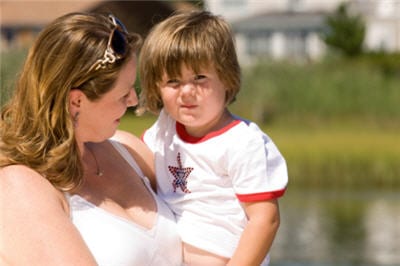Spend some time in any PTA meeting, Mommy & Me group, or even a playdate with friends and it isn?t long before the conversation turns into a worried discussion about Megan?s Law and the sex offender information that parents can now readily access with just a few clicks of their computer mouse.
Parents everywhere are feverishly checking these websites, sometimes weekly or even daily, to see if a registered sex offender resides nearby. Unfortunately, there are a few flaws in this perceived ?safety net? that well-intentioned parents should know.
Don?t get me wrong, I am a HUGE proponent of Megan’s Law and the information it provides.
I strongly believe that once a sex offender has been released back into the community, the public has the absolute right to know their whereabouts.
But? focusing solely on this component of child safety can do a serious disservice to our kids, IF we stop there.
A Basic Overview of Megan’s Law
Megan?s Law is a federal law, signed on May 17, 1996 by President Bill Clinton. It is named for 7 year old Megan Nicole Kanka of Hamilton Township, New Jersey, who tragically, was sexually abused and killed in 1994 by a twice-convicted pedophile who lived across the street from her home. Unaware of his presence and criminal history, Megan?s parents, Maureen and Richard Kanka, were devastated and outraged. They established the Megan Nicole Kanka Foundation and lobbied government officials to create a law which would require all 50 states to release information regarding the presence of convicted sex offenders in our communities. In it?s most basic terms, the law mandates that the public has the right to know the whereabouts of convicted sex offenders once they have been released, and that all 50 states must make this information available to the public.
Many states have created a dedicated Megan?s Law website, to which the public can log onto through their own personal computer and research the data pertinent to their town or local community.
There are several ways you can check the Megan?s Law sex offender register in your state. In my home state of California, the website is www.meganslaw.ca.gov . To access the information in your state, you can visit www.familywatchdog.us. This website provides a free national sex offender registry link and also contains excellent safety information.
Only Part of the Solution?
While Megan?s Law is an excellent awareness tool and provides vital information to the public, parents must remember that it can only do so much.
To begin with, a sex offender register is not a perfect system. In some instances, registered offenders may or may not actually be living where they are listed. Depending on which state you live in, you may even have some registered offenders whose whereabouts are not made public due to an exclusionary clause in the law. For example, some offenders fall into the ?undisclosed category? ? which means they are registered with the state, but their information is not accessible on the website. According to the California Dept. of Justice, approximately 25% of registered offenders are excluded from public disclosure by law, depending on the type of crime that person has been convicted of. More importantly, parents must remember that there are plenty of sex offenders out there who simply haven?t been caught, and therefore, are not listed on any register. As a result, we need to protect our kids from those who may be ?flying under the radar? as it were.
What?s A Parent To Do?
Be a PRO-ACTIVE parent rather than a REACTIVE one. A PRO-ACTIVE parent can beat a sex offender at their own game.
By now, many parents are somewhat familiar with the real statistic that 90% of child sexual abuse happens by someone the child knows, not by a stranger. Since that?s the real issue, it?s time we started looking at prevention education in a way actually protects our children.
Kids need to be taught how to recognize and defend their personal boundaries with adults they interact with. They need to understand what is appropriate and inappropriate behavior from a grown up (or even an older child), and what to do if they get a red flag or ?uh-oh? feeling from someone?s improper actions.
In plain English, kids need to know what to do if ?Coach Smith? tries to touch a private part of their body, or if a babysitter or relative wants to play a physical game that just feels weird or ?yucky?. These are much more common scenarios than the stranger who may or may not be living down the street.
Megan?s Law is a good start in protecting our kids. Yet, it?s still only half the battle. With smart prevention education in conjunction with Megan?s Law, we can offer each other a real solution to keeping our children safe. Listed below are 10 prevention tips for parents
1.
Don’t equate stranger with danger. Teach your child how to recognize a potentially dangerous action or situation instead. (?Thumbs up or thumbs down!?)
2.
Be involved in your child?s activities. As a ?visible parent?, you?ll have a better opportunity to observe how other adults interact with your child.
3.
Screen caregivers and babysitters carefully. Always check references ? no matter who they come recommended by.
4.
Pay attention to clues and cues in other adults? behavior around your child. A predator?s grooming tricks can be very subtle at first. For example, is there someone who continually tries to arrange ?alone time? with your child, often working very hard to create the opportunity by using flattery or suggesting outings that don?t include you?
5.
Listen to your child, especially if they consistently don?t want to be around a particular person, such as a babysitter, relative, or family friend. They may be sensing ?a red flag? that you are unaware of.
6.
Let children decide for themselves how they want to express affection. Do not force them to a hug or kiss another person if they don?t want to.
7.
Spend quality time with your children. Kids who are starved for affection or attention can be vulnerable targets for a child molester or predator.
8.
Be alert to anyone who insists on being physical with your child (hugging, kissing, tickling, wrestling, touching) especially when the child seems uneasy or has asked them to stop.
9.
Let children know they have the right to say NO to any unwanted touches or physical attention. It?s okay to say NO even to a grownup or a bigger kid, and then immediately tell a grownup they trust (like mom or dad) as soon as they can.
10.
Review and practice basic safety skills with your children often. Children need to hear the information more than just once to really understand.
About the author
Pattie Fitzgerald is the founder of Safely Ever After, Inc. and is recognized as a leading expert in the field of childhood sexual abuse prevention education. She is certified as a Child Safety Educator and Child Visitation Monitor, and has been working in the field of child advocacy for over ten years. As a former preschool teacher, Pattie blends her expertise as an educator and, more importantly as a MOM, to teach parents and kids every where the most effective, up-to-date safety strategies WITHOUT using fear tactics.
Admired for her positive approach and warm, compassionate style, Pattie has created her unique brand of ?Safe-Smarts? which parents and children are embracing across the country. Her published works have appeared in newspapers, parenting magazines, and trade journals throughout the United States, and she has been featured on Good Morning America, CNN Headline News, MSNBC, KCBS, KABC and KNBC news as well as countless national radio programs. For more information, please visit www.safelyeverafter.com





